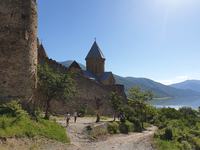Photo. Ananuri Castle in its almost full pride. The castle was also named Ananuri in the respect of a woman who is a hero for Georgians. You can see it from the road and the view invites you to stop and step in.
On our way from Tbilisi to the town of Kazbegi we stopped at Ananuri Castle. To put it in another way: we were almost sucked into this site by its mysterious look, and we were eager to explore. From a short distance from the road we could see most of the entire complex with the river and surrounding green hills. Already from the first glimpse we could admire the amazing architecture, and then it was impossible to pass. The village Ananuri is located on the main trade rout leading to the North, to Russia and in past it was part of the Great Silk Road. Nowadays the road is called the Georgian Military Highway. Ananuri Castle located around 70 kilometres from Tbilisi.
This complex on the Aragvi River is one of the best-protected monuments in Georgia. It`s absolutely breathtaking and it live up to everything you'd imagine to be in a fairytale. Already from our first steps we could feel ancient history and enjoy the beautiful nature. This medieval monument was originally used for a military purpose and only later it became the residence of the Dukes of Aragvi, from the 13th century (source: Wikipedia).
Watch more photos on our Facebook page Travel Explorations.
The fortress was built in the valley between the two rivers of Aragvi and Vedzatkhevi, in order to block any enemy armies to pass without found themselves caught in this natural “gate“ . The fortifications consist of two castles joined by a massive wall . The upper fortification with a large square tower, known as Sheupovari. The lower fortification, with a round tower, is now mostly in ruins.
We climbed the tallest of the fortress towers, both for getting a beautiul view, and for feeling the dramatic history. Actually the only view was through a small opening in the wall. It was here that the last defenders were killed in 1739 when a rival eristavi set fire to Ananuri and murdered the Aragvi eristavi’s family.
Ananuri is also on the UNESCO tentative list.
The castle was the scene of numerous battles. In 1739, Ananuri was attacked by forces from a rival duchy, commanded by Shanshe of Ksani and was set on fire. The Aragvi clan was massacred. However, four years later, the local peasants revolted against rule by the Shamshe, killing the usurpers and inviting King Teimuraz II to rule directly over them. However, in 1746, King Teimuraz was forced to suppress another peasant uprising, with the help of King Erekle II of Kakheti. The fortress remained in use until the beginning of the 19th century. In 2007, the complex has been on the tentative list for inclusion into the UNESCO World Heritage Site program.
The fortifications consist of two castles joined by a crenellated curtain wall. The upper fortification with a large square tower, known as Sheupovari, is well preserved and is the location of the last defense of the Aragvi against the Shamshe. The lower fortification, with a round tower, is mostly in ruins.
Within the complex, amongst other buildings, there are two churches. The older Church of the Virgin, which abuts a tall square tower, has the graves of some of the Dukes of Aragvi. It dates from the first half of the 17th century, and was built of brick. The interior is no longer decorated, but of interest is a stone baldaquin erected by the widow of the Duke Edishera, who died in 1674.
The larger Church of the Assumption (Ghvtismshobeli), built in 1689 for the son of Duke Bardzem. It is a central dome style structure with richly decorated facades, including a carved north entrance and a carved grapevine cross on the south façade. It also contains the remains of a number of frescoes, most of which were destroyed by the fire in the 18th century.
Stein Morten Lund, 15th June 2019
Additional information
Contact information to the tour operator we used in Georgia:
Gamarjoba Georgia Tours
ADDRESS: 10 Tsinandali street , Tbilisi , Georgia
TEL NO: +995 599 060 315 | +995 593 60 95 60
EMAIL: info@gamarjobageorgiatours.com












